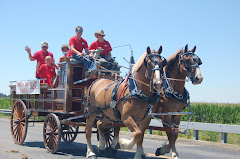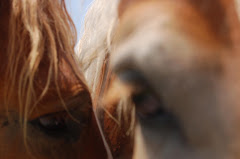

The nerve damage is commonly caused by horses colliding with other horses or objects.....ie stall doors, trees...etc. Nerve damage is also caused by ill fitting work collars putting pressure on the nerve. This is seen in horses which are used to pull wagons, carts and freight.
Pain may or may not be present in the affected limb. As the muscles atrophy worsens, the horse may have difficulty extending the forelimb. Also, horses may swing their shoulder out due to instability or loosening of the shoulder joint from lack of muscle and ligament tone.
Treatment of sweeney involves anti-inflammatories and physical therapy. Nerves can heal and possibly even regenerate if the injury is not too extensive and enough time is allowed. Muscle massage and electrical stimulation has been used. For cases with extensive scarring, surgery can be performed to release the nerve and hopefully regain function. In the case of a poorly fitted collar, rest and a properly adjusted collar is indicated.

 The Percheron horse originated from France in the province of Le Perche, located about 50 miles southwest of Paris. Traditionally, the Percheron breed was a breed of greys. Used as a war horse, the French Knight is almost always seen on a grey or white horse. When the day of the war horse was over, Percherons were used to pull heavy stage coaches in France. These horses could trot 7-10 miles per hour with the endurance to perform day in and day out. The light colored greys and whites were easily seen at night and thus preferred. When the railroad replaced the stage coaches and horses began to replace oxen in agriculture, the need for a heavier draft horse grew. The breeders of Le Perche complied. From war horse to light draft coach to heavy draft, the Percheron breed was developed.
The Percheron horse originated from France in the province of Le Perche, located about 50 miles southwest of Paris. Traditionally, the Percheron breed was a breed of greys. Used as a war horse, the French Knight is almost always seen on a grey or white horse. When the day of the war horse was over, Percherons were used to pull heavy stage coaches in France. These horses could trot 7-10 miles per hour with the endurance to perform day in and day out. The light colored greys and whites were easily seen at night and thus preferred. When the railroad replaced the stage coaches and horses began to replace oxen in agriculture, the need for a heavier draft horse grew. The breeders of Le Perche complied. From war horse to light draft coach to heavy draft, the Percheron breed was developed. 

 Just as other European draft horses, the Percheron breed was heavily imported into the US in the 1870s and 80s. The current Percheron Horse Association of America was formed in 1905. The number of registrations grew until the 1940s and WWII. The low point in Percheron registrations came in 1954 when just 85 head were recorded. Just like the Belgian breed, a handful of breeders persisted and Americans rediscoverd the usefulness of the draft horse. Since then, the Percheron breed has seen a resurgence in its numbers and value.
Just as other European draft horses, the Percheron breed was heavily imported into the US in the 1870s and 80s. The current Percheron Horse Association of America was formed in 1905. The number of registrations grew until the 1940s and WWII. The low point in Percheron registrations came in 1954 when just 85 head were recorded. Just like the Belgian breed, a handful of breeders persisted and Americans rediscoverd the usefulness of the draft horse. Since then, the Percheron breed has seen a resurgence in its numbers and value.
 The Clydesdale breed originated from Scotland in the district of Lanarkshire. As with the other European draft breeds, these horses were originally developed for use in warfare to carry knights into battle. A heavier breed was needed to carry armor-clad warriors to war. When the need for war horses declined, the Clydesdale horse was bred not only for agriculture but for heavy haulage in the coalfields of Lanarkshire. The Clydesdale breed flourished in the late 19th century leading to large numbers of exports into Australia, New Zealand, Canada and the United States. Today, the Clydesdale is virtually the only draft breed in its native Scotland.
The Clydesdale breed originated from Scotland in the district of Lanarkshire. As with the other European draft breeds, these horses were originally developed for use in warfare to carry knights into battle. A heavier breed was needed to carry armor-clad warriors to war. When the need for war horses declined, the Clydesdale horse was bred not only for agriculture but for heavy haulage in the coalfields of Lanarkshire. The Clydesdale breed flourished in the late 19th century leading to large numbers of exports into Australia, New Zealand, Canada and the United States. Today, the Clydesdale is virtually the only draft breed in its native Scotland.  The picture above is "Samurai" owned by Dr. Linda-first place gelding and 1st place American Bred Gelding at the National Clydesdale show.
The picture above is "Samurai" owned by Dr. Linda-first place gelding and 1st place American Bred Gelding at the National Clydesdale show.  A clydesdale halter class.
A clydesdale halter class. 











